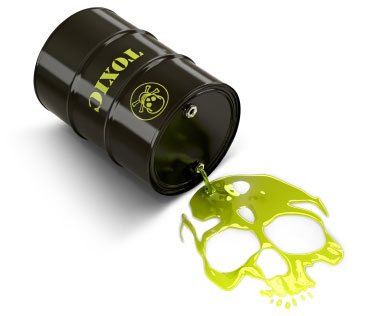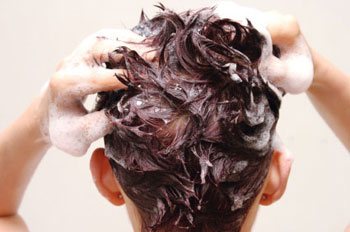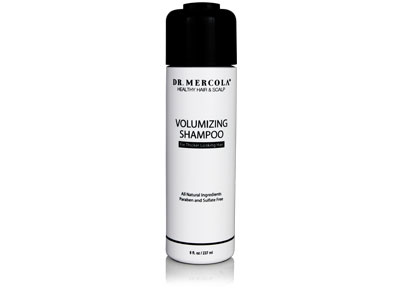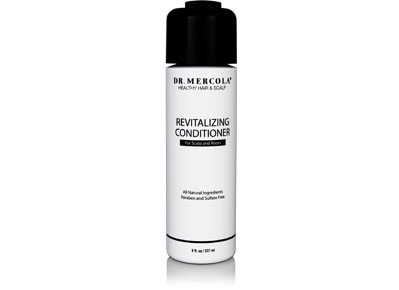Volumizing Shampoo / Revitalizing Conditioner
Description
"I Recommend You STOP Using Your Shampoo and Conditioner Until You Read This"
Despite the potentially toxic ingredients in your shampoo and conditioner, the FDA doesn't have the resources to stop them from flooding the market...
- 5 Potentially Toxic Ingredients Found in Most Shampoos and Conditioners
Do you get a dose of them every time you wash your hair? - Why the FDA is Allowing Shampoo Manufacturers to Get Away With What I Consider To Be Open Fraud
In trying to formulate a safe, non-toxic shampoo and conditioner, my team learned a lot about what’s been going on in the hair care industry for more than the last decade. It’s a sad situation that could be robbing you and your family of better health
And if you are using shampoo and conditioner right now, you need to hear everything I am about to share with you.
Don’t just take my word for it. Consider what a prominent Senator said at a Senate Hearing on the FDA Reform on September 10, 1997...
"The Cosmetics Industry Has Borrowed a Page from the Playbook of the
Tobacco Industry by Putting Profits Ahead of Public Health"
And while the bigwigs in the hair care industry don’t want you to know this, every time you put shampoo or conditioner into your hair, you may be putting yourself in harm’s way. Just take a look at your shampoo and conditioner the next time you shower and ask yourself...
"Does my Shampoo or Conditioner Contain Any of These
5 Potentially Toxic Ingredients?"
Toxic Ingredient #1: Sodium Lauryl Sulfate
Did you know the same ingredient which produces all that foam and lather when you shampoo your hair is also the ingredient used in car washes and garages as a degreasing agent?
It’s true. And not only does it act as a penetration enhancer (allowing other potentially toxic ingredients to slip into your bloodstream), but according to the Environmental Working Group’s "Skin Deep: Cosmetic Safety Reviews", research studies on SLS have shown links to...
- Irritation of skin and eyes
- Organ toxicity
- Development / reproductive toxicity
- Neurotoxicity, endocrine disruption, ecotoxicological, and biochemical or cellular changes
- Possible mutations and cancer
If you visit the SLS page on the Environmental Working Group’s (a non-profit public-interest research group known for making connections between chemical exposure and adverse health conditions) website, you will see a very long list of health concerns and associated research studies. In fact, you will also see their mention of nearly 16,000 studies in the PubMed science library (as well as their link to that list) about the toxicity of this chemical.
So look for it in your hair care products. It also goes by a number of different names including sodium lauryl sulfate, sodium laureth sulfate, ammonium laurel sulfate, sodium dodecylsulfate, sulfuric acid, sodium salt sulfuric acid, A12-00356, Akyposal SDS, Aquarex ME, and Aquarex methyl.
Toxic Ingredient #2: Dioxane
In the medical journal Cancer’s 2007 review of mammary carcinogens, dioxane was identified as one of the 216 chemicals which was linked to breast cancer in rodents.
Not that this is anything new. Its connection to carcinogens was first reported in 1965 and confirmed in 1978.
In fact, back in 1985, the FDA recognized these dangers, and requested that manufacturers voluntarily limit dioxane levels in cosmetics and personal-care products to 10 parts per million.
But it hasn’t happened.
In fact, Los Angeles Times staff writer, Marla Cone, in February 2007 reported that all eighteen personal care products for both adults and children which she had tested by an independent laboratory were contaminated with high levels of dioxane.
Toxic Ingredient #3: Diethanolamine or DEA
In a recent FDA report, approximately 42% of all cosmetics were contaminated with NDEA, with shampoos having the highest concentrations. DEA also readily reacts with nitrite preservatives and contaminants to create nitrosodiethanolamine (NDEA), a known and potent carcinogen.
This is a big problem because DEA seems to block absorption of the nutrient choline, which is vital to brain development. Pregnant women actually require extra choline so they can pass it onto their fetus.
An associate dean for research at the UNC School of Public Health mentioned that choline is necessary to help provide proper nutrients for a healthy baby; stating that, "At this point it is a caution. But it would probably be prudent to look at labels and try to limit exposure until we know more."
Toxic Ingredient #4: MSG
You’ve been told to avoid MSG in your food, right? After all, many people experience symptoms like headaches, dizziness, and stomach discomfort after consuming MSG-containing products. And according to the FDA, MSG side effects include: numbness, burning sensations, tingling, facial pressure, headaches, nausea, drowsiness and weakness, among other problems.
But did you know MSG, short for monosodium glutamate, is also more than likely in your shampoo, often secretly hidden and referred to as amino acids, yeast extract, nayad, glutamic acid, or glutamates?
Toxic Ingredient #5: Propylene Glycol
This active ingredient is found in engine coolants and antifreeze, airplane de-icers, tire sealants, rubber cleaners, polyurethane cushions, paints, adhesives, enamels and varnishes, and in many products as a solvent or surfactant.
And guess what? Despite the fact the material safety data sheet warns users to avoid skin contact with propylene glycol as it is a strong skin irritant and can also cause liver abnormalities and kidney damage, it’s more than likely in your shampoo!
Okay, so now that you’ve read about these 5 potentially toxic ingredients, let me ask you two critical questions: If you knew of a food which contained all of these toxins...
- Would you add it to your grocery basket on a week to week basis?
- Would you feed it to your children?
Of course, you wouldn’t.
But it’s safe because your skin is protecting you, right? Wrong. The reality is your skin is often a carrier, not a barrier and...
Toxins in Your Shampoo and Conditioner May Be
More Toxic Than Those in Your Food

You might think that because your skin is about one tenth of an inch thick, it protects your body from absorbing the many things you come into contact with.
But the truth is, when you consume toxins in foods, such as pesticides in fruit and vegetables, the enzymes in your saliva and stomach often break them down and flush them out of your body. Food also passes through your liver and kidneys. The toxins which make it through are detoxified to varying degrees by enzymes before they reach the remainder of your body.
However when toxins are absorbed through your skin, they bypass your liver and enter your bloodstream and tissues – with absolutely no protection whatsoever.
Think of it like this: when you put shampoo or conditioner into your hair, the twenty blood vessels, 650 sweat glands, and 1,000 nerve endings soak in the toxins.
And some studies suggest skin can sometimes absorb more than your digestive tract. According to evidence presented at 1978 Congressional hearings, the absorption of the carcinogen nitrosodiethanolamine (NDELA), which is commonly found in shampoo products, was shown to be more than 100 times greater when exposure came through your skin than via your mouth. What’s more...
A Hot Shower Opens Up Pores in Your Skin
and May Make it Easier for Toxins To Enter Your Body
Here’s how it works: When you have a warm
shower, your pores automatically open up, which may
make it easier for sodium laurel sulfate... DEA... MSG... propylene glycol, and Ethylene Oxide to enter your blood stream.
And while you have been told about the damaging effects of pesticides and additives in food, the ugly truth about the damage shampoo and conditioner may do to your body has been hidden until now.
If You Think You Can Trust the Labels
on Your Hair Care Products THINK AGAIN!
For instance, about half of all the labels on 14,200 products examined by the Environmental Working Group ended up having mislabelled ingredients with some misspelled, and others having different names for the same ingredient depending on the manufacturer.
What’s more, there were 41 online retailers of cosmetics identified by EWG who failed to post any of their ingredients online. And when the FDA was pressured to make these retailers conform, they replied: "There is no requirement that a manufacturer put an ingredient list on a website."
The reality is your shampoo and conditioner may be just as toxic. In fact, it’s a serious case of "Buyer Beware" because it is the manufacturer’s responsibility to determine whether a product is safe.
In my opinion, it’s an outrage. At least with cigarettes you know they are dangerous to your health. But the manufacturers selling you shampoo and conditioner are taking reckless advantage of the less stringent FDA regulations applicable to cosmetics.
The FDA Regulations (21 CFR Sec. 740.10) state quite clearly that "Each ingredient used in a cosmetic product and each finished cosmetic product shall be adequately substantiated for safety prior to marketing. Any such ingredient or product whose safety is not adequately substantiated prior to marketing is misbranded unless it contains the following conspicuous statement on the principal display panel:
"WARNING. THE SAFETY OF THIS PRODUCT HAS NOT BEEN DETERMINED."
So who’s in control of the safety?
The manufacturers. It seems that the FDA is allowing them to pass their own judgement about the safety of their product.
What a joke.
The FDA regulations are intended to protect you from dangerous products by insisting products which contain dangerous ingredients include warning statements. But the reality is that the agency does not have adequate resources to enforce this requirement.
Your Hairdresser Knows Best Right? Wrong!
A group which was founded in 1894 called the Cosmetic, Toiletry, and Fragrance Association (which in 2007 changed its name to the Personal Care Products Council), is comprised of over 600 different distributors and manufacturers of personal care, cosmetic, and fragrance companies that are committed to championing "voluntary regulation and reasonable government requirement." But here’s the ugly truth...
As Stacy Malkan made quite clear in her 2007 book, Not Just a Pretty Face, the following untruth was on its website as of January, 2007: "The FDA routinely conducts studies and tests to ensure the safety of all cosmetic products... FDA’s legal authority over cosmetics is comparable with its authority over foods, non-prescription drugs, and non-prescription medical devices."
However, the FDA simply does not have the resources to "routinely" test skin products like shampoo in the way I believe they should.
And as long as the manufacturers’ profits stay high, I do not believe that anything is about to change. Meanwhile, most people are content to put their trust in the FDA and take them at face value believing if the products actually contained threats to their health, the FDA would have the resources to routinely take enforcement action.
In my opinion, nothing could be further from the truth.
And that’s why several months ago I decided that until Congress gives the Food and Drug Administration the required resources to do its job, I’ll do what I can to expose the truth about the risks that can be associated with hair care products.
The Problem with Natural Shampoos

The primary ingredient found in many natural shampoos is soap based. The problem with many of these "natural" shampoos is that they typically don’t clean very well, and tend to form scum by reacting with calcium and magnesium ions present in water. This leaves a residue that can leave your hair feeling unclean and looking rather dull.
What’s more, the pH of soap-based cleansers is very basic, about 8-9--which can cause damage to your hair by lifting cuticles and causing reactions which affect the disulfide bonds in your hair. Ingredients like sodium silicate and borax are added to help overcome the scum formation and dulling effect on your hair.
Additionally, many of the natural products on the market today don’t create a luxurious, creamy, rich lather.
Everything is Made From Natural Ingredients – See Why I Believe
the Purity is Supreme
The ingredients in my Shampoo and Revitalizing Conditioner are completely natural and of the highest quality available. Aside from water, here’s a breakdown of what’s in each product...
| Shampoo | Conditioner |
|---|---|
| Botanical extract of chamomile: Helps restore your hair’s shine and brings out its natural highlights. In fact, regular use can strengthen your hair and even help prevent split ends and breakages. | Botanical extract of chamomile: See left. |
| Red clover: Used topically to promote healthier-looking skin and hair. | Red clover: See left |
| Comfrey: Rich in minerals and B vitamins. | Comfrey: See left |
| Canadian Balsam: Made from the resin of the balsam fir tree which provides the product with its viscosity. | Canadian Balsam: See left |
| Surfactant derived from vegetable oil: Designed to reduce the surface tension between water and other liquids. | Sunflower (Helanthus Annus) Extract: When used in hair care, due to its rich polyphenol and vitamin E content, it protects hair color. It also helps provide a photo-protective seal around hair shafts from splits, therefore enhancing the sheen of your hair and promoting healthier-looking hair. |
| Kosher Vegetable Glycerin: A component of fat or oil which has been used since1857 in the Western World. | Witch Hazel Leaf Extract: An extract of the leaves of Hamamelisviginiana that is often used in aftershave lotions. |
| Cetyl Betaine (Natural fatty methyl esters): Used to thicken shampoo and stabilize foam. | Cetyl Alchohol (coconut oil): Used as a foam boosting surfactant. |
| Surfactant derived from glucose: Helps oil and water to mix so the two will not separate - resulting in a smooth, stable shampoo. | Natural Thickening Agent derived from cellulose:Keeps conditioner from being too runny. |
| Triticum Vulgare (wheat) protein: Obtained from wheat germ, this is a light yellow or reddish oil which offers conditioning, moisturizing, and helps your hair retain its moisture and overall appearance. | Natural conditioner derived from Guar Gum: Extracted from the guar bean. It is a natural thickener. |
| Citric acid: A non-toxic pH adjuster and foam stabilizer. | Vanilla fruit extract: A source of polyphenols which exhibit antioxidant activity. |
| Natural peppermint oil: Helps soothe skin. | Vanilla Planifolia Fruit Oil: Perhaps the hottest new substance in the international skin care industry. This plant is tucked away on the tiny island of Madagascar and is known for holding promise for exceptional skin rejuvenation. |
| Sorbic acid: A natural-based preservative which protects the balance of shampoo. | Aloe barbadensis Leaf Juice: More commonly known as aloe vera, this liquid is known to soothe skin. |
| Natural Vitamin E: Far superior to synthetic vitamin E due to its higher potency. It does a far better job of promoting more resilient-looking skin. | Citric Acid: A naturally occurring organic acid used as a gentle way to adjust pH down. |
| Grapefruit Seed Extract: A liquid derived from seeds, pulp, and white membranes of grapefruit. | |
| Mentha Piperita (Peppermint) Oil: One of the most popular tonic herbs known to modern men and women. |
Take a moment to check out the chart above and then compare the ingredients with the veritable witch’s brew of potentially carcinogenic ingredients and contaminants found in those you’ll find at your local salon and supermarket shelves. You’ll see that my Volumizing Shampoo and Revitalizing Conditioner gives you all the goodness without the potentially negative effects.
You won’t find any of the nasty toxins commonly found in shampoos such as Sodium Lauryl Sulfate, parabens, Ethylene oxide, DEA, MSG, or propylene glycol.
But you will find a shampoo that, with continued usage improves your hair’s texture and strength without stripping away essential oils. In fact, this invigorating and purifying formula helps to eliminate build-up from your hair and scalp, and encourages healthy-looking hair, leaving your hair looking thicker, fuller, and shinier.
How does my shampoo and conditioner manage to moisturize without stripping your hair? It all boils down to the fact that the ingredients are designed to nourish and strengthen your hair, while gently cleansing away impurities and toxins--providing your hair with the natural conditioning and healthy-looking results it deserves.
It reconstructs damaged hair… adds noticeable volume and shine… moisturizes… radically reduces the appearance of split ends… and shields your hair from damage due to the environment, and chemical treatments, without weighing your hair down.
So why not give your hair the best world-class ingredients today so you can enjoy naturally healthy-looking hair?
Volumizing Shampoo and Revitalizing Conditioner is gentle enough on hair for daily use. It will boost shine by nourishing your scalp, and leave your hair feeling healthier . And because it’s free of parabens and sulfates, it’s also one of the safest products to use on stressed or damaged hair that has undergone any chemical treatment.
The Bottom Line is You Have Two Choices...
One... Continue using your current shampoo and conditioner because you are used to it. Put your head in the sand, trust the FDA, and ignore the fact that the majority of shampoos and conditioners on the market are the beauty equivalent of junk food--designed to fill a temporary craving. And ignore the fact you’re probably absorbing carcinogenic ingredients directly into your bloodstream.
Or two... Get your hands on a shampoo and conditioner which is natural and free of toxins.
Volumizing Shampoo and Revitalizing Conditioner will give you the same results (without the toxins) as the products you buy from your local hair salon.
And that leads me to my final point, a question, really...
Are You Happy to Continue Using Products With Potential Toxins
Every Time You Wash Your Hair?
If you care for your health... if you don’t like the idea of potentially soaking up MSG... DEA... Sodium Lauryl Sulfate... Propylene Glycol and Ethylene Oxide every time you wash your hair... and if my natural alternative sounds appealing... then what do you have to lose?
Why not discover how easy and enjoyable it is to keep your hair looking fresh, clean, and shiny without using a product with potential toxins?
Remember, what you place on your skin may end up going directly into your bloodstream.
Other Information
Disclaimer #2: The entire contents of the statements and information pertaining to Dr. Mercola Products as well as all video and written articles on this website authored by Dr. Joseph Mercola are based upon the opinions of Dr. Mercola, unless otherwise noted. Individual articles are based upon the opinions of the respective author, who retains copyright as marked. The information on this website is not intended to replace a one-on-one relationship with a qualified health care professional and is not intended as medical advice. It is intended as a sharing of knowledge and information from the research and experience of Dr. Mercola and his community. Dr. Mercola encourages you to make your own health care decisions based upon your research and in partnership with a qualified health care professional.
Mercola.com, Dr. Joseph Mercola, or Body Charge Nutrition may have authored the presented information in whole or in part and therefore retain and reserve all copyright respectively.
<script type="text/javascript" src="https://www.mercola.com/js/citation.js" language="javascript"></script>
How to Order
- To order the shampoo, click on the "Natural Shampoo" button; enter order quantity; click the "Add to Shopping Cart" button.
- Watch for the notification over the "Add to Shopping Cart" button as it processes the order then informs you that it has been added.
- To order the conditioner, click on the "Natural Conditioner" button; enter order quantity; click the "Add to Shopping Cart" button.
- To order either the shampoo or conditioner, click either the "Natural Shampoo" or "Natural Conditioner" button; enter your order quantity; click the "Add to Shopping Cart" button.
- If you are having difficulties, or the website is not working properly, please contact us via email at customerservice@old.bodychargenutrition.com
- Thank you for your order!




 Body Charge Nutrition is a premium nutritional supplement provider based in Western Canada offering only products and information that are of the highest quality and integrity. Through knowledge and personal experience, it is our goal to assist you with taking control of your health.
Body Charge Nutrition is a premium nutritional supplement provider based in Western Canada offering only products and information that are of the highest quality and integrity. Through knowledge and personal experience, it is our goal to assist you with taking control of your health.